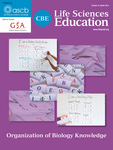A Year of Firsts
This has been a year of firsts for CBE—Life Sciences Education (LSE). LSE was the first journal to publish a collection of education research and practice articles integrating physics and biology education. Articles that comprise the Integrating Physics and Biology issue take important steps toward responding to the call for teaching and learning at the intersection of biology and physics, and raise interesting and significant questions for future research and practice in physics and biology education research. LSE published its first research methods essay, the first in a series intended to translate social science methods in ways that are compelling to and approachable for trained biologists. LSE is also publishing articles from an increasingly international group of authors on a broader range of issues in biology education—from how to effectively implement professional development on teaching, to how to measure knowledge about fundamental biological ideas. LSE's growth has spurred us to initiate continuous publication in 2014, such that articles accepted for publication are available as quickly as possible rather than held for four predefined dates.
Several firsts have occurred behind the scenes as well. Our publisher, the American Society for Cell Biology (ASCB), has established a fund to ensure the long-term sustainability of the journal without resorting to subscription fees or page charges. ASCB has seeded the fund with an initial commitment of $100,000. This novel commitment of funds demonstrates that ASCB is serious about sustaining the journal and disseminating current knowledge about biology teaching and learning to readers around the world. The Genetics Society of America (GSA) has joined ASCB as the LSE's first editorial partner. The formation of editorial partnerships is far more than a means to ensure the journal's financial sustainability. The GSA and ASCB partnership represents progress toward the journal's long-held goal of promoting education and learning across all biological disciplines. LSE is keen to partner with additional life sciences organizations to maximize our collective impact and reduce the cost of publishing peer-reviewed education research. You too can partner with LSE by donating online at: https://www.ascb.org/ascbsec/donations/donation.cfm. With your help, LSE can remain a premier journal for open access to life sciences education research and evidence-based biology teaching.
The broader biology education community has also experienced several firsts. The first Chronicling the Change meeting was held as part of the Vision and Change initiative. The meeting highlighted the progress individuals and institutions are making in adopting Vision and Change principles. The Partnership for Undergraduate Life Science Education (PULSE) Fellows released their first major products—the Framework for Change and Vision & Change Rubrics. Other groups are also producing firsts aimed at promoting widespread adoption of evidence-based practices in biology teaching. During 2014, with leadership from Malcolm Campbell, Kimberly Tanner, and William Wood, iBiology will launch its Scientific Teaching Series project to help new and aspiring biology faculty design and implement evidence-based pedagogy. Under the direction of Editor-in-Chief Robin Wright, CourseSource will publish its inaugural issue of peer-reviewed biology education materials designed according to the principles of scientific teaching and “backward design.”
Where will the biology education community be after all of these firsts? Teachers will be better at articulating learning objectives that are meaningful and measurable. Students will benefit from assessments that align with clear learning objectives. Courses will engage students in learning activities that align with learning objectives, reveal where students are in their learning, and prepare students to be successful on summative assessments. Homework and projects will provide our students with opportunities to verbalize their thinking, reflect on their knowledge, engage in meaningful interactions, and receive informative feedback. Effective teaching begins by assessing students—what do they know and how are they thinking? Effective instruction provides students with opportunities to practice the kind of thinking we expect from them and that they will need to succeed in STEM education and careers. However, not all faculty embrace evidence-based teaching, because change is difficult, change takes time, and change requires a shift in beliefs and culture (Gess-Newsome et al., 2003; Henderson et al., 2011; Brownell and Tanner, 2012).
I encourage you to accomplish some firsts of your own to mentor others in the use of evidence-based instruction. Invite a colleague to your class to watch you teach. Ask him or her to focus on what the students are doing and how your teaching prompts students to actively engage in learning. Share an LSE article with someone and offer to discuss the article over coffee. Volunteer to teach a lesson in a colleague's class to demonstrate active learning and what students can achieve when given the opportunity. Gather a subset of your colleagues to take turns observing one another's classes and giving feedback to help improve student learning. Involve an undergraduate, graduate, or postdoctoral researcher in collecting assessment data in one of your classes and developing strategies to reduce student confusion or lack of mastery of core concepts. Share the PULSE rubrics with your department head and start a conversation about where your department is and how to make progress in adopting evidence-based teaching practices. Implement a new strategy or intervention that has been shown to be effective. Put your students’ learning first and join the global community as we celebrate the ever-expanding examples of educational firsts.



